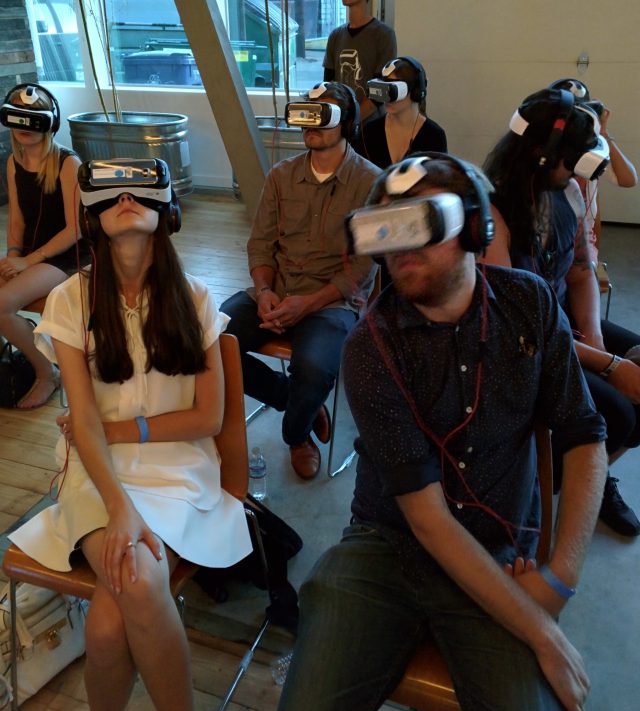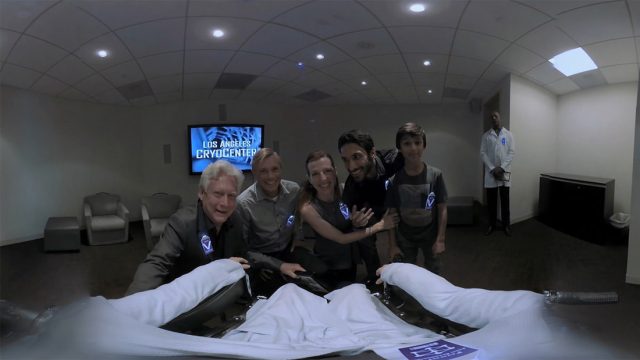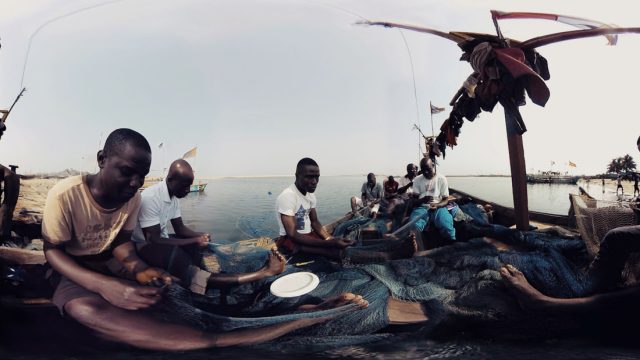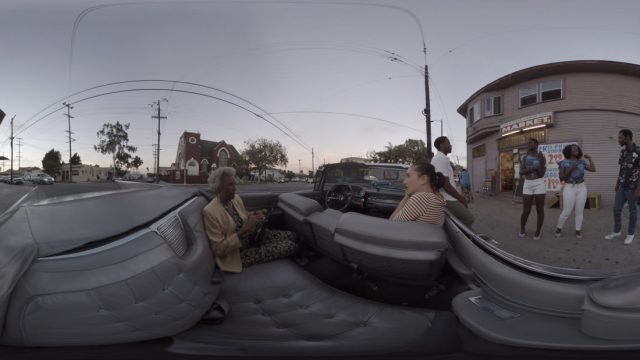
Did you hear? Virtual reality is legitimate now, because filmmakers have found it.
Forget those childish toys that you call video games and think beyond those little 360-degree videos captured at concerts. VR is now a place for capital-F Films, complete with New York Times celebrations and dedicated exhibits at Sundance. Recent VR films have some impressive sounding premises, too: immersion in the wilderness alongside bison and cheetahs; trippy, sense-filling music videos; stark, racially charged drives through poor neighborhoods; and much more.
VR filmmakers have taken some pretty diverse approaches, but most of them have one unfortunate thing in common: an overreaction to the form. In their rush to put viewers inside their concepts, these burgeoning creators forgot about the importance of directing and cinematography—a fact that I, a devout believer in VR's future, can no longer stomach.
It's not just a Cardboard problem
In its January push for VR content, the Sundance Film Festival made a pretty bold move. It sponsored and distributed most of the fest's VR films for free to anybody with compatible equipment. That audience wasn't just Oculus early adopters or GearVR purchasers, either, as anybody with a Google Cardboard kit and a working smartphone could join in.
Cardboard works by splitting your phone's display in half as lined up to a curved lens rig, which, when pressed against your face, is supposed to present a stereoscopic image that moves around as your head moves. Look up, look down, look around, and the image on your screen should move around accordingly with no lag—meaning, you should wind up with a working, poor-man's VR rig. These little sets are cheap to make, and millions have been given away by Google (including a one-million-strong giveaway as a partnership with The New York Times), so Sundance has quite an audience with the bare minimum stuff needed to check these films out. No laminate badges, flights to Utah, nor paid apps required.
However, Ars' cursory Cardboard tests of these films, distributed in such apps as the Sundance VR app, Vrse, and Jaunt, ranged from underwhelming to criminally painful.I personally tested four different compatible smartphones, including two iPhones, a Nexus 5, and the particularly pixel-dense Nexus 6, in two Cardboard rigs, and every time, at least a few of the films on offer looked horrible through Cardboard's lens-to-phone system. This issue seemed to vary with every app/video/phone/headset combo, and sometimes, the issue would pop up in the middle of a video because my face was just slightly out of alignment. Friends reported the same issues anecdotally. As such, I waited until I had a Samsung GearVR headset in hand so that I could remove any technical variables from my assessment.
The more stable headset, paired with a nice pair of headphones, let me focus on the more damning issues that were common across the films: the need to make me, the viewer, take on the additional burdens of director and cinematographer.

The trouble began with Defrost, one of Sundance's more acclaimed VR entries. This five-minute short stars Carl Weathers as a doctor who talks to you throughout the runtime. You "star" in the film as a woman who was cryogenically frozen until doctors could find a cure for your disease, then you are awoken decades later. You watch the scene play out while your character sits paralyzed in a wheelchair, and the scene transitions from a roll through hospital hallways to a meeting room encounter with your husband and two children, all of whom have aged in real-time while you've been in deep freeze.
As the scene played, I found myself looking and hunting all over my full 360-degree viewing range. Every time I heard a sound or got bored with a passage, I'd look to the left, right, or even behind me, and there'd be something happening. Additionally, the Samsung VR, whose field of view is a few degrees larger than what's offered by Google Cardboard, still limited my ability to take in every active participant in a scene at one time, which really stood out when the film presented my husband, two children, son-in-law, and grandchild in front of me, all talking to and gawking at me.
This was all in spite of the film doing its damnedest to keep its action front-and-center, by the way. Defrost's hospital sequence didn't fill my peripheral vision with flashes of light or loud noises, yet it did repeatedly insert content in its fringes, from a solemn, swaying Carl Weathers at the side of the room to a behind-my-back hospital attendant, a silent man whose sole job was to wheel me around, look angry, and keep his mouth shut.
VR films: All effort, no payoff
After watching this film, I thought a lot about another world of visual storytelling where actors seem to be in the same room as you and where viewers feel like they've really been warped into a live story: the theatre stage. Musicals and plays have existed for a pretty long time—from what I hear, longer than the VCR!—and they've pretty much perfected the format.
Theater companies generally don't want viewers to spend a lot of energy—or deal with neck strain—to appreciate their shows. That's not to say the theatre world has avoided all gimmickry, including in-the-round presentations, hulking multi-person costumes, and a modern wave of "immersive" concepts inspired by the macabre, sexually charged Sleep No More. But the latter case isn't even a proper comparison to sit-down VR, as Sleep No More compares more favorably to video games than to other mediums—what with its encouragement that viewers walk around a mansion and choose which characters to follow, along with the show's request that viewers pick up and rifle through any letters and objects they find.

Sit-down VR films offer none of those active benefits—meaning, nothing tactile and nothing in the way of choice. Instead, they're all effort, no payoff. In the case of scene-based films like Waves of Grace and Condition One, which tell an Ebola survivor's story and showcase wildlife, respectively, the filmmakers drop a camera into real-life scenes and walk away, often offering little in the way of effective framing or valuable visual clues. Viewers wind up looking like lunatics in the real world as they tilt and spin all over the place trying to see if they've missed any content.
That's only worse in music videos like the Reggie Watts-loaded Waves or the Lewis Carroll-inspired LSD trip Fabulous Wonderland, which bombard viewers with audio and visual information on all sides and demand all kinds of neck-craning to absorb what appears above, below, and all around. (These videos, in particular, expose the psuedo-VR effect that manifests when a viewer moves too quickly, only to find that only their rotational position is tracked, as opposed to their absolute position—meaning, while you may move forward, the stuff you see does not. This stuff is a one-way ticket to Barftown, MA.)
No matter how gimmicky a theater production might play out, you'll rarely find one that fails to focus its lighting and visual activity in one general direction. Perhaps a few peripheral moments pop up, but they can be absorbed without taking full attention away from a scene's primary action thanks to the viewer's position in the crowd and smart direction. Conversely, every VR film failing I saw made me ask out loud, "why can't I just watch this on a TV screen"—and this is coming from a major, unabashed VR apologist, someone who has truly drunk the VR Kool-Aid time after time.
Of course, bombardment can prove artistically compelling—when many conversations overlap with each other, when video screens pop up to offer contradictory information, or when other intense stuff tells a production's real story. We look forward to VR filmmakers who grasp the possibilities that in-your-face headset displays might offer, all while tightening their grasp on the concept of directing and filming something that a viewer can actively adjust with a turn of the neck.

For now, we're stuck with promising-yet-lacking efforts like Hard World For Small Things—the most disappointing Sundance VR offering of them all, thanks to its combination of incredible acting performances, beautiful cinematography, stark subject matter, and failing to capably juggle so many elements at once. Viewers sit in the backseat of a restored, classic car as two black men and a black woman drive to a corner store, stop to talk to friends, and then are accosted by white, plainclothes police officers.
What the film does with a sense of presence—of being part of that drive through a neighborhood, like you're part of the conversation—is striking and almost certainly impossible to convey with any other format. But before its incredible ending, the film presents four conversations in parallel, all of which require looking away from one to see and hear the other. This doesn't play out in a compelling, "the noise is the sum of its parts" manner; instead, it sees a great concept slamming head-first into the realities of current VR headsets, in which viewpoints are choked into tiny fields of view, and comfort suffers as a result.
Hard World's best moments hint at the quality of VR film productions to come, but hopefully its worst moments hint to where the format will improve as filmmakers adopt the best practices that 3D game makers have practiced for decades. Good 3D storytelling is as much about giving viewers power as it is about taking it away—about blacking out and obstructing freedom in ways that both focus our attention and convey an important truth (where you're not allowed to go and what that means, for example).
VR may soon force viewers to confront interesting and even harrowing new concepts in the arts world. Until then, the people who make those VR films need to confront a few truths of their own. Otherwise, we're going to nod our heads 'no' to the expectation of painfully nodding our heads all over virtual worlds.
reader comments
54